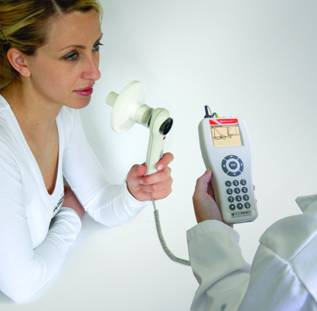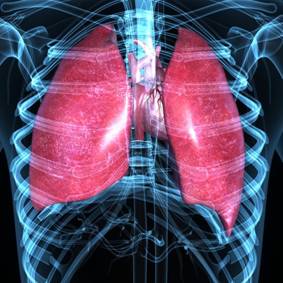Archives
Does COPD Begin in Childhood?
 To mark World COPD Day,an annual event organized by the Global Initiative for Chronic Obstructive Lung Disease (GOLD) to improve awareness and care of chronic obstructive pulmonary disease (COPD), Lystra Hayden, Instructor in Pediatrics at Harvard Medical School, set on a task to discover the relationship between childhood pneumonia and COPD development in smokers.
To mark World COPD Day,an annual event organized by the Global Initiative for Chronic Obstructive Lung Disease (GOLD) to improve awareness and care of chronic obstructive pulmonary disease (COPD), Lystra Hayden, Instructor in Pediatrics at Harvard Medical School, set on a task to discover the relationship between childhood pneumonia and COPD development in smokers.
A recent publication in Respiratory Research, examined the risk for COPD in adult smokers who had pneumonia in childhood. With 10,000 participants ages 45-80, the study concluded that “adult smokers, having had childhood pneumonia was associated with a higher risk of COPD, decreased lung function, and increased disease of the airways on chest CT scans.” Additionally, Hayden noted that “the greatest association with COPD was seen in subjects who had both pneumonia and asthma during childhood.”
It is the researchers hope that these findings will help medical providers to “decrease the risk of future COPD by trying to prevent childhood pneumonias, especially among asthmatics.” Based on the findings, Hayden also suggested that medical providers offer counsel to patients who had pneumonia in childhood of the increased risk for COPD if they start smoking.
In the future Hayden hopes to use these outcomes to identify genetic associations that could define subtypes of COPD. Hayden is hopeful that through genetic testing, understanding a patient’s genetic risk will help physicians better understand who will develop lung diseases such as asthma and COPD, while discovering the “best ways to both prevent disease and treat each individual patient.”
Current Diagnostic Criteria for COPD Inadequate, Experts Say
 A recent analysis published in the BMJ details findings that indicate chronic obstructive pulmonary disease (COPD) management programs and guidelines consistently over-diagnose elderly patients and underdiagnose young ones. The analysis calls for the adoption of “lower limits of normal (LLN) criteria for airflow obstruction that are specific for different populations.”
A recent analysis published in the BMJ details findings that indicate chronic obstructive pulmonary disease (COPD) management programs and guidelines consistently over-diagnose elderly patients and underdiagnose young ones. The analysis calls for the adoption of “lower limits of normal (LLN) criteria for airflow obstruction that are specific for different populations.”
Martin R. Miller, MD, from the University of Birmingham in the United Kingdom, and Mark L. Levy, MBChB, from the Harrow Clinical Commissioning Group in London, United Kingdom, created the Global Initiative for Obstructive Lung Disease (GOLD) strategy with the intention to create “a new and simple threshold for airway obstruction.” Unfortunately, upon diligent new research, Miller and Levy both concluded that the GOLD standard – created in 2001- did not effectively diagnose COPD.
Miller and Levy also calculated that “as many as 13 percent of patients diagnosed with COPD under the GOLD criteria may be misdiagnosed (under-diagnosis as well as over-diagnosis). This misdiagnosis could lead to poor outcomes that result from inappropriate treatment.” Misdiagnosis may also result in patients missing out on necessary treatment.
The goal of Miller and Levy’s ongoing research is to help physicians move beyond spirometry and the GOLD standards, which can create “the myth of a health smoker”, and allow them to more accurately “diagnose patients who have symptoms of COPD. This is necessary because COPD is currently under-diagnosed during the early stages of disease, when preventive strategies might be most useful.”
Subsequently, the National Institutes of Health has also funded a study to “facilitate diagnosis of COPD in smokers and other patients. The goal is to create a five-question questionnaire that is able to diagnose clinically significant COPD.” Until the new guidelines are releases, Miller encourages physicians to incorporate “clinical perspective” into their tests for diagnoses.
Click Here to Access the Full Story on Medscape
Study Shows COPD Re-admissions Can Be Reduced
 A new sleep center study shows re-hospitalization of patients with chronic obstructive pulmonary disease (COPD) can be significantly reduced using a multi-faceted approach.
A new sleep center study shows re-hospitalization of patients with chronic obstructive pulmonary disease (COPD) can be significantly reduced using a multi-faceted approach.
Published in Journal of Clinical Sleep Medicine, Steven Coughlin, PhD, Director of Strategy, Health Economics and Reimbursement at Philips Respironics, and colleagues used a retrospective approach to look at a quality improvement (QI) program and its effect on patients with COPD.
The program focused on COPD patients who had been hospitalized “twice in a single year as a result of acute COPD exacerbation.” Those patients were then treated according to a multi-faceted intervention plan that included:
● nocturnal administration of advanced positive airway pressure (PAP), or noninvasive positive pressure ventilation (NIPPV)
● medication reconciliation by a pharmacist
● adequate provision of oxygen
● patient education
● ongoing respiratory therapist-led care
The proportion of patients who were readmitted the following year decreased by almost 80%, from 397 to 9 out of the 397 patients that met all of the eligibility criteria. “A total of 70 patients died during within one year of the initiation of the intervention.”
In a recent development, the Centers for Medicare and Medicaid Services (CMS) has begun tracking COPD-related re-hospitalizations. Additionally, the Agency of Healthcare Research and Quality (AHRQ) “classifies COPD as a condition for which good outpatient care can potentially reduce hospitalization, prevent complications, and reduce disease severity.” While this study focused on “only one quality improvement program and one sleep center, the authors say it provides enough information to warrant further research.”
Living an Active Life with COPD
 For those living with chronic obstructive pulmonary disease (COPD), exercise can be a daunting thought. Some people may even fear the idea, as it is oftentimes a very difficult challenge. COPD makes even simple physical activities like “a short walk or climbing the stairs exhausting, but research shows that exercise can “improve COPD patients’ physical and emotional well-being, while inactivity can worsen their condition.”
For those living with chronic obstructive pulmonary disease (COPD), exercise can be a daunting thought. Some people may even fear the idea, as it is oftentimes a very difficult challenge. COPD makes even simple physical activities like “a short walk or climbing the stairs exhausting, but research shows that exercise can “improve COPD patients’ physical and emotional well-being, while inactivity can worsen their condition.”
“As a person’s symptoms become more severe, they’ll avoid any kind of activity that will cause breathing distress,” Randolph Lipchik, MD, a pulmonologist at Froedtert Hospital and the Medical College of Wisconsin in Milwaukee. “This leads to a spiral of slowly becoming more and more deconditioned, and unable to do even basic physical activity.” Additionally, the American College of Sports Medicine warns that if COPD patients choose to remain inactive, their heart function and muscle mass can decline.
When people suffer from the shortness of breath and lack of energy associated with COPD, they tend to give up activities they used to enjoy as well as social interaction, leading to an estimated 40 percent of patients suffering from depression. Researchers recommend checking with a doctor before beginning any kind of exercise program as they may want to “monitor oxygen levels and heart rate, and suggest working with a therapist to identify the right exercises for you.”
“Sometimes [patients] need reassurance that they’re okay to do something that’s not a marathon,” says Ashley Henderson, MD, director of the pulmonary diseases and critical care medicine fellowship program at University of North Carolina School of Medicine.
Recommended exercises include low-impact aerobic movements such as “walking, riding a stationary bike, and swimming use large muscle groups and can help improve breathing. Lipchik adds that “mild strength training, such as lifting light weights, can prevent muscles from weakening. But don’t overdo it”, he says.
Order Sets Help Decrease COPD Hospitalization
 According to a recent study published in the Canadian Respiratory Journal, the use of order sets by physicians for the management of chronic obstructive pulmonary disease (COPD) is able to reduce hospitalization time and medication use outcomes. Hospitalization time and frequency continues to be a problem for patients of chronic diseases, specifically those with COPD, whose symptoms can flare from any number of activities.
According to a recent study published in the Canadian Respiratory Journal, the use of order sets by physicians for the management of chronic obstructive pulmonary disease (COPD) is able to reduce hospitalization time and medication use outcomes. Hospitalization time and frequency continues to be a problem for patients of chronic diseases, specifically those with COPD, whose symptoms can flare from any number of activities.
Not familiar with order sets?
Order sets are a series of checklist recommendations designed to assist physicians in the decision making process about the most appropriate course of care in COPD patients. With COPD acting as the leading cause of hospitalization COPD in Canada, Samir Gupta, lead investigator of the study and a respirologist at St. Michael’s Hospital, was prompted to seek out just how helpful order sets are to lessening hospital admissions for those with worsening COPD.
Gupta believed that “by providing doctors with the best, evidence-based information at the point in time when they are deciding on medications and tests for their patients, doctors’ adherence to best practices [will improve].”
Study researchers “encouraged both physicians and other members of the hospital staff to use the order set, which provided comprehensive admission instructions. The checklist was created by a team from the respirology and internal medicine wards at St. Michael’s, particularly focusing on patients who were admitted to the hospital due to worsening COPD”.
Results indicated that the “length of patients’ average hospital stay decreased approximately two-and-a-half days in cases where physicians used the order sets”. “This is a dramatic drop, and points to one of the key, positive findings in our research,” noted Gupta. “The faster we can get patients home and breathing easier, the better for our patients and for our health-care system.”
Other findings indicated that that more patients were treated with proper antibiotics, leading to “fewer cases of over-treatment and antibiotic resistance, according to the order sets”.
Click Here to Access the Full Study on Canadian Respiratory Journal
COPD Risk Is Higher in Poor and Rural Communities
 According to a new study released by the Johns Hopkins University School of Medicine in Baltimore, Maryland, the chance of having chronic obstructive pulmonary disease (COPD) is almost 12 percent higher if you live in a poor or rural community than if you live in a more urban or community-centric area. But why is this?
According to a new study released by the Johns Hopkins University School of Medicine in Baltimore, Maryland, the chance of having chronic obstructive pulmonary disease (COPD) is almost 12 percent higher if you live in a poor or rural community than if you live in a more urban or community-centric area. But why is this?
As the third leading cause of death in the United States, COPD makes even the most normal daily activities a struggle as those who suffer from the disease have trouble breathing and catching their breath. Researchers used data from the National Health Interview Survey, the U.S. Census, and the National Center for Health Statistics Urban-Rural Classification Scheme to study 87,701 participants. The participants self-reported to emphysema, chronic bronchitis and/or formally diagnosed COPD.
The goal of the study was to “identify the prevalence of COPD in urban and rural areas in the U.S. and determine how residence, region, poverty, race and ethnicity and other factors influence COPD rate.” The findings of the study indicated that biomass fuels (biomass is biological material derived from living, or recently living, organisms), found in predominantly rural areas played a role in the higher number of self-reported COPD cases.
The results also suggest that public advocacy, which appeared to be lacking in many rural communities, was also associated with a higher cessation rate.
Research Shows E-Cigarette Vapor Could Lead to Emphysema
Central Michigan University (CMU)researchers have found that inhaling the vapor of electronic cigarettes could lead to emphysema and even minimal exposure (as little as an hour) to the vapor created harmful changes to human bronchial epithelial cells that were used during testing.
E-cigarette companies tout these battery operated devices as a safe alternative to traditional cigarettes with claims that the devices are “tar- and tobacco-free”, but the nicotine and other chemicals that become an aerosol or vapor disrupt the protein processes in bronchial cells, gradually damaging alveoli.
Because the vapor takes the same path cigarette smoke and second-hand smoke takes in our bodies, people are just as likely to develop complications in breathing due to alveoli damage as those who smoke traditional cigarettes.
"What we are talking about is how these proteins are made and how they are degraded. This process of proteostasis in our cells has to be very — in layman's terms — tightly regulated, because if it goes off-balance, it's a big problem,” said Neeraj Vij, associate professor of molecular and cell biology, CMU.
Additionally, a recent report published in the New York Times found that “e-cigarette use among middle- and high-school students tripled from 2013 to 2014, and e-cigarettes are now more popular among high-school students than traditional cigarettes.” Study results, such as CMU’s, are timely and necessary as it becomes critical that teens and adults alike are properly informed about the hazards and risks associated with these devices.
Regenerative Medicine Breakthrough Pushes COPD Treatment Forward, Marks Win For Method
 Scientists are moving beyond stem cells to research the ability of fully mature lung cells in the hope that they will help repair tissue damage in patients with conditions such as chronic obstructive pulmonary disease (COPD). In the study, currently published in Nature Communications, for the first time ever, the team observed the type 1 cells give rise to type 2 cells over about three weeks in various models of regeneration.
Scientists are moving beyond stem cells to research the ability of fully mature lung cells in the hope that they will help repair tissue damage in patients with conditions such as chronic obstructive pulmonary disease (COPD). In the study, currently published in Nature Communications, for the first time ever, the team observed the type 1 cells give rise to type 2 cells over about three weeks in various models of regeneration.
To elaborate on types of lung cells and the role they play, there are two main types - Type 1 cells, which is where oxygen and carbon dioxide are exchanged during breathing, and type 2, which secrete surfactants, a type of lubricant integral to the breathing process.
Researcher and University of Pennsylvania cardiologist Rajan Jain noted that new cells were observed growing back into new areas of the lung. “It's as if the lung knows it has to grow back and can call into action some type 1 cells to help in that process," According to Dr. Jon Eptein, also of the University of Pennsylvania, said the “observation suggested that there is much more flexibility in the pulmonary system than previously believed.”
So what does this mean for COPD patients?
If this research proves accurate and consistent, the ability to regrow damaged lung tissue on demand could completely change treatment options for COPD patients. Physicians could focus less on trying to specialize stem cells and could essentially force mature lung cells to revert back to a stem, specializing themselves.
Female Smokers More Susceptible to Emphysema
 Due to a gene mutation called telomerase reverse transcriptase (TERT), researchers from Johns Hopkins Kimmel Cancer Center have found that females may be more susceptible to emphysema than men.
Due to a gene mutation called telomerase reverse transcriptase (TERT), researchers from Johns Hopkins Kimmel Cancer Center have found that females may be more susceptible to emphysema than men.
According to research published in the Journal of Clinical Investigation, of the 292 smokers studied for the mutation, “3 participants were identified to have the telomerase reverse transcriptase (TERT) gene mutation”. The mutation reduces the life of telomeres, which have the ability to repair the ends of chromosomes from degradation during cell division. This reduction results in telomere life shortening and higher risk for emphysema in those with the mutation.
To compare, the researchers also studied 50 Johns Hopkins patients who displayed symptoms of telomere shortening. Their findings indicated that of the “39 nonsmokers in that group, there were no cases of emphysema. There were 11 patients who were nonsmokers, including 6 females – all 6 females and one other patient all had emphysema. The researchers believe this suggests that female smokers with telomerase related mutations might be more susceptible to emphysema”.
“If we know that they have a telomerase mutation, it may help us take care of them in a more sophisticated way and delay the onset of those diseases” said study leader Mary Armanios, MD. Armanios also noted that a genetic history of lung diseases may also be a factor, along with age, and those women with any or all of these symptoms may be likely to have the mutation.
Identifying Which Smartphone App Features Aid Smoking Cessation
Smoking has been associated with the deaths of nearly six million people worldwide each year. So it’s no wonder there are over 400 smartphone applications, or apps, available to help people quit smoking. But which ones really work? And why?
Over 780,000 smoking cessation apps are downloaded per month, however, very little research has been done to research whether these apps really help people quit or not, until now.
Dr. Jaimee Heffner, PhD, and Dr. Jonathan Bricker, PhD, along with colleagues in the Public Health Sciences Division at the Fred Hutchinson Cancer Research Center evaluated the effectiveness of certain smartphone app techniques by tracking usage of 41 different app features, and then comparing this use against whether users successfully quit smoking. The team hopes this research will help increase the effectiveness of their recently piloted app “SmartQuit”.
“By studying how users engage with specific app features and whether use of these features predicts successful smoking cessation," said lead author Dr. Heffner, "we are identifying the basic building blocks needed to create effective interventions on the smartphone app platform, which reaches millions of smokers each year and has the potential to transform treatment delivery."
To the researchers’ surprise, “only 2 of the top 10 most-used features were prospectively associated with 30 days abstinence at the 60 day follow-up: viewing the quit plan and tracking the practice of letting urges pass.”
By updating and continually evaluating the effectiveness of cessation apps, researchers can more accurately predict which features will be most likely to help people quit smoking. The team adds that additional future work will allow for future experimentation of the causal relationships between feature usage and smoking cessation. "This would provide the most accurate and rigorous test of the each feature’s contribution to successful quitting,” said Dr. Heffner.




